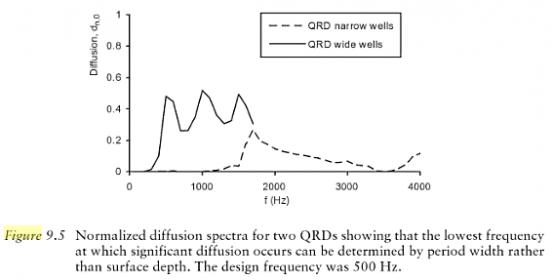i would appreciate it if one of you 'smart guys' could interpret the conclusions of your 'exchange' for us with wording we are likely to understand.
Just trying to point out that sticking to established design guidelines may be a good idea.

kareface said:
Where did you read that it was from an array of 20 or more? I might of missed something, but everything I read suggests that he's only using 2 diffusers in the test. Now that I think about it, the diffusion coefficient values in the graph you posted for a QRD of that width are what you would expect, maybe even a bit low.
I'm well aware that one reads what one wants to read. It is however too explisit for me to doubt in this case. Have read The Book over and over, across many years. It'll always be extremely handy to have around as it's the most comprehensive source of information on absorption and diffusion in my library. Well worth the price! The diffuser theories generally deals with periodic repetetions of diffusers, not the response from a single diffuser. When Cox and D'Antonio writes "a diffuser", they mean a periodic array of a diffuser. Periodicity is a requisite for the expected results to appear. Figure 9.6 is the exception as this illustrates a single period vs periodic devices. This is the paragraph after the one on repeat width. If google books works for you it's here to read:
http://books.google.no/books?id=f19...f the period width (Nw) is too narrow&f=false
The periodicity and the reason I assume 2.1 meter width or multiplies thereof is mentioned here:
"This is illustrated in figure 9.4 where the scattering from diffusers of different period widths is shown. These are both n=7 QRD's with a design frequency of 500 Hz.
The well widths are 3 and 9 cm, which means that the period widths are 21 and 70cm respectively. The number of periods for each diffuser is set so that the overall widths of the devices are the same for a fair comparison. For the narrow wells and period width, shown right, the low frequency limit of diffusion is determined by the period width and not by the maximum depth."
The subtitle to figure 9.4: "Overall width kept the same by changing number of periods".
If the overall width of the two different diffuser arrays are the same, the arrays are ten 21cm panels and three 70cm panels, or twenty 21cm's and six 70cm's, etc.
The Trevor Cox text also deals with repetitions:
"If the aim of a diffuser is to generate reflected energy at oblique angles, it is necessary for the diffuser to have a
period width (or repeat distance) larger than the wavelength of the lowest frequency where scattering is required. For
a periodic device, having the width equal to the wavelength means that three reflection lobes are generated in the directions - 90º, 0º and 90º (relative to the surface normal). Some socalled diffusers, produce no significant scattering over the bandwidth expected, because the bandwidth has been assumed to be defined by the diffuser depth, and no account of the period width has been taken."
http://www.rpginc.com/news/library/tyndall_paper.pdf




